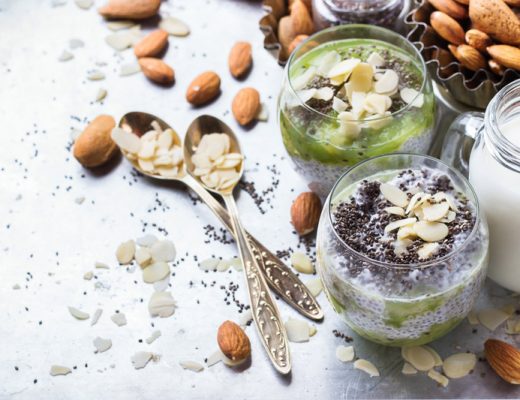In a time when everyone is obsessed with counting calories, carbs, and just about everything in between, we’ve seen a shift in the food industry. Just about every food group that once was deemed unhealthy has made an effort to get back in the good graces of dieters and casual consumers alike. Everything from popcorn, to soda, to gummies have been given a facelift to try to appease the masses. In this country the masses are generally looking for a shortcut to health or a loophole in the system. Enter “healthy ice cream.”
One of the most common bandwagons to jump on these days is the healthy ice cream trend. I too was once a loyal consumer of diet ice cream. In fact, I cringe thinking about the number of grocery stores I ran to trying to find the most elusive flavors. Whether it’s mint chip, smores, or cinnamon roll, healthy ice creams have painted a picture to consumers that you can have your cake and eat it too. Even the big guys that once churned out good old fashioned ice cream (ya know, the kind with cream and sugar) are pumping out the low-calorie versions. I suppose supply and demand is the real MVP here.
As I’ve mentioned before, I am not a certified health professional. I am also not in the business of prescribing diets to people or recommending that anyone eat or avoid certain things. I am however in the business of providing information and taking a closer look at some of the fads that exist so that you can make an informed decision for your own health and lifestyle. Let’s consider some of the commonly found ingredients and aspects (ahem, marketing) of healthy ice cream…
First off, healthy ice creams often advertise right on the container how many calories is in the whole pint. This aspect alone sends the message that it is completely reasonable to eat an entire pint of ice cream without any of the guilt or consequences, even though each pint has four or more recommended servings.
It has been proven time and time again low-fat foods do not result in weight loss. Rather, eating low-fat foods somehow communicates that it’s ok to overeat and ignore our body’s natural signals of satiety. By removing healthy fats found in high-quality dairy, that signal is dulled or turned off completely which allows us to finish the whole pint of the “healthy” stuff without blinking.
Now, let’s talk sugar. It should be no surprise that eating a pint of ice cream will give you a hefty dose of sugar. Not all nutrition labels reflect that reality though. Many healthy ice creams utilize artificial sugars, sugar alcohols and other processed sweeteners so they don’t taste like a shoe. Those sneaky little bastards rarely count towards the sugar tally on the back of the carton.
As science suggests, artificial sugars may yield less desirable outcomes than their pure sugar counterparts. Artificial sugar intake has been shown to cause digestive issues including bloating, diarrhea, irritation of the stomach lining and intestines, gas and stomach pain. Additionally, more and more research emerges that link fake sugar and cancer. Yikes.
 Next, let’s tackle the protein argument. Most low calorie ice creams pack a protein punch and we have become a society of protein-obsessed individuals. Many of the brands out there utilize highly processed dairy to add protein to the mix and attract consumers. While protein is an essential macro nutrient in our diets, if we are relying on ice cream and highly processed protein sources to deliver our daily dose, we’re likely to find ourselves deficient in many vitamins and minerals. Case in point, a chicken salad with veggies contains the same amount of protein as a pint of the frozen stuff, give or take. The ice cream option significantly lacks any other nutrients that the salad and vegetables provide, fiber, vitamin C, and folate to name a few. If we’re in it for the protein, ice cream and grilled chicken is quite simply comparing apples and oranges.
Next, let’s tackle the protein argument. Most low calorie ice creams pack a protein punch and we have become a society of protein-obsessed individuals. Many of the brands out there utilize highly processed dairy to add protein to the mix and attract consumers. While protein is an essential macro nutrient in our diets, if we are relying on ice cream and highly processed protein sources to deliver our daily dose, we’re likely to find ourselves deficient in many vitamins and minerals. Case in point, a chicken salad with veggies contains the same amount of protein as a pint of the frozen stuff, give or take. The ice cream option significantly lacks any other nutrients that the salad and vegetables provide, fiber, vitamin C, and folate to name a few. If we’re in it for the protein, ice cream and grilled chicken is quite simply comparing apples and oranges.
Natural flavors also make an appearance on many ingredient lists. The term natural flavors sounds more appealing than the alternative, artificial flavors, but is it really? After I poked around a bit, I learned that natural and artificial flavorings are really not that different and are not regulated very closely. They are added to products so that they stay consistent in taste. You can buy a pint of ice cream in Denver one week, then buy the same pint in New York City the next week and it will taste the same because of natural flavors. The issue is that any one natural flavor may actually contain 50-100 ingredients. Sure, they are derived from a compound found in nature originally, but are highly processed after the fact and not everything, even if it’s natural, should be consumed.
Now, in the interest of transparency, I’m going to tell you a fun fact that will likely ruin your life. You’ve been warned. The natural flavors in ice creams and other products that have a vanilla flavor are often derived from discharge in beaver’s sex glands. Yep. You read that right. But, hey! It’s natural.
Lastly, there’s a question of  the gums. All of the healthy alternative ice creams I’ve seen include one or more gums in the ingredient list. Most people overlook these items as a necessary ingredient in any item we buy at the store. I had to dig a little deeper to understand the purpose of these bad boys. To summarize, all gums are added to food as a thickening agent as a cheaper and tasteless alternative to things like corn. Most gums are derived from seeds, trees and other plants, but should not be overlooked. Like sugar, gums are generally tough on the gut. Even if you don’t suffer from digestive issues, the consumption of gums can throw off the balance of good gut flora and disrupt digestion.
the gums. All of the healthy alternative ice creams I’ve seen include one or more gums in the ingredient list. Most people overlook these items as a necessary ingredient in any item we buy at the store. I had to dig a little deeper to understand the purpose of these bad boys. To summarize, all gums are added to food as a thickening agent as a cheaper and tasteless alternative to things like corn. Most gums are derived from seeds, trees and other plants, but should not be overlooked. Like sugar, gums are generally tough on the gut. Even if you don’t suffer from digestive issues, the consumption of gums can throw off the balance of good gut flora and disrupt digestion.
So, here’s the deal. I’m a big believer that foods do not have morality. If you choose to eat diet foods or eat an entire pint of ice cream (the low-calorie or otherwise) it will not make you a bad person. In the same sense, if you do not eat these things it will not make you a good person. For my own health and diet, these healthy ice cream alternatives are simply not worth the risk. If I have a hankering for ice cream, I opt for a small serving of the real deal. I find I am much more satisfied with a full fat scoop of rocky road than a pint of the chemical elixer the other stuff provides. I look for ice cream options that have few ingredients and ones that I can pronounce. If you ever made ice cream in a bag in elementary school with cream and sugar you know what I’m talking about (if you didn’t, I’m sorry about your childhood).





1 Comment
Ashleigh
April 29, 2018 at 5:56 pmMay never eat vanilla again. It’s a good thing I like salted caramel!